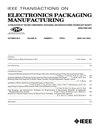Fabrication of Polymer Silver Conductor Using Inkjet Printing and Low Temperature Sintering Process
IEEE Transactions on Electronics Packaging Manufacturing
Pub Date : 2008-10-03
DOI:10.1109/TEPM.2008.2004554
引用次数: 14
Abstract
In this paper, silver powders with a uniform particle size of 0.2-0.4 mum and an excellent dispersibility were applied to produce a conductive ink for the inkjet printing process. The thermal behaviors of silver particles sintered at different temperature were investigated through X-ray diffraction (XRD) patterns. It was found out that both the particle size and crystal grains increase during the surface diffusion and sintering process. A drop-on-demand (DOD) inkjet printing system was employed to print the conductor by using as-mentioned silver particles suspended in terpineol/polyketone (PK) system as conductive materials. The optimized value of WPK/Wsilver was 5%, corresponding to a resistivity of 2.0 muOmega ldr cm. It was revealed that an increase in the WPK/Wsilver ratio resulted in the increase in both the resistivity and adhesion strength of the conductor. The scanning electron microscopy (SEM) analysis based on the microstructures of silver conductor further illustrates that the densification of conductor and long-range interparticle connectivity ensure the silver conductor a low resistivity. The adhesiveness effect from PK resin enables the conductor a high adhesion strength.用喷墨打印和低温烧结工艺制备聚合物银导体
本文采用粒径均匀的0.2-0.4 μ m、分散性优异的银粉制备了用于喷墨印刷工艺的导电油墨。通过x射线衍射(XRD)研究了不同温度下烧结银颗粒的热行为。结果表明,在表面扩散和烧结过程中,颗粒尺寸和晶粒均增大。以悬浮在松油醇/聚酮(PK)体系中的银颗粒为导电材料,采用滴-按需(DOD)喷墨打印系统打印导体。WPK/Wsilver的优化值为5%,对应的电阻率为2.0 μ ω ldr cm。结果表明,WPK/Wsilver比的增加导致导体的电阻率和粘附强度的增加。基于银导体微观结构的扫描电镜(SEM)分析进一步表明,导体的致密化和粒子间的远距离连通性保证了银导体的低电阻率。PK树脂的粘附作用使导体具有较高的粘附强度。
本文章由计算机程序翻译,如有差异,请以英文原文为准。
求助全文
约1分钟内获得全文
求助全文

 求助内容:
求助内容: 应助结果提醒方式:
应助结果提醒方式:


